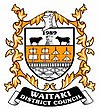Waitaki District
| Waitaki District | ||
|---|---|---|
| District | ||

Waitaki District Council building, Thames Street, Oamaru
|
||
|
||
 Location of the Waitaki District within the South Island |
||
| Country | New Zealand | |
| Regions |
|
|
| Formed | 1989 | |
| Seat | Oamaru | |
| Government | ||
| • Mayor | Gary Kircher | |
| • Parliamentary electorate | Waitaki | |
| • Territorial authority | Waitaki District Council | |
| Area | ||
| • Total | 7,148.05 km2 (2,759.88 sq mi) | |
| Population (June 2016) | ||
| • Total | 20,829 | |
| • Density | 2.9/km2 (7.5/sq mi) | |
| Time zone | NZST (UTC+12) | |
| • Summer (DST) | NZDT (UTC+13) | |
| Postcode(s) | 7977 | |
| Area code(s) | 03 | |
| Website | Waitaki District Council | |
The Waitaki district, in the Canterbury and Otago regions of New Zealand, straddles the traditional border between the two regions, the Waitaki River.
It has a land area of 7,151.94 km² (2,761.38 sq mi), of which 59.28% is in the Canterbury Region and 40.72% in the Otago Region. It is the only district in the South Island that lies in two regions. A major reason for this split was the governance of the Waitaki River which forms a political boundary between Canterbury and Otago. With major hydro schemes on this river it was decided to place the entire catchment in one administrative region, thus forming the split. Some people who fall into the Canterbury Region of Waitaki District still regard themselves as part of Otago, and attempts have been made in the past to change the boundary. The district, which is agricultural by nature, comprises the wide alluvial fan of the river, and runs inland along the banks of the river, this forming a roughly triangular region.
The Waitaki District's population is 22,100 (June 2016). Of this, 13,850 (63%) live in Oamaru, the district seat, in Otago.
The Waitaki District is made up of the former Waitaki County, Waihemo County and Oamaru Borough, which were amalgamated in 1989. It is governed by the Waitaki District Council.
A relatively sparsely settled area, the District does have a wide number of farms. However, in recent times (late 2000s), numerous proposals for new farming operations have locals fearing that the agriculture will be transformed from often family-held farms to large agribusiness operations causing increased local ecologic damage and siphoning off capital overseas.
Coordinates: 44°55′34″S 170°38′06″E / 44.926°S 170.635°E
...
Wikipedia

